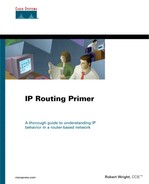Poison Reverse and Triggered Updates
Poison reverseis when a router informs other routers that routes they were once capable of reaching via a particular interface are no longer reachable because the interface has gone down.
Routers normally react to a poison reverse message by immediately placing the poisoned routes into holddown instead of waiting for the invalid timer to expire. This saves convergence time, as much as 180 seconds (default invalid timer), depending on how soon after a regular update a poison reverse update arrives.
In Figure 2-10, RouterA's serial 1 interface is shut down. RouterA can no longer reach 168.71.9.0 and 168.71.8.0 out of serial 1.
Figure 2-10. Serial 1 on RouterA has been shut down.

By poisoning the routes out serial 0, RouterA is informing any other routers downstream from serial 0 that it can no longer reach these two subnets. This is, in essence, what a poison advertisement is.
When it receives these poison advertisements, RouterB deletes its references to the two subnets and puts them in holddown. This saves RouterB from having to wait until the invalid timers fire for these subnets to go into holddown.
The debug messages in this scenario have been edited to only show activities related to subnets 168.71.8.0 and 168.71.9.0. Here, you can see the output of debug ip rip from RouterA when serial 1 is shut down. The shutdown command is shown on the line separating the two sections of the debug message.
RouterA#debug ip rip RouterA#config term RouterA-config#interface serial 1 RouterA#-config-if# Oct 3 17:02:25: RIP: sending v1 update to 255.255.255.255 via Serial0 (168.71.6.1) Oct 3 17:02:25: subnet 168.71.9.0, metric 1 Oct 3 17:02:25: subnet 168.71.8.0, metric 2 RouterA-config-if#shutdown Oct 3 17:02:33: RIP: sending v1 update to 255.255.255.255 via Serial0 (168.71.6.1) Oct 3 17:02:33: subnet 168.71.9.0, metric 16 Oct 3 17:02:33: subnet 168.71.8.0, metric 16 RouterA#
RouterA sent an update to RouterB just before the shutdowncommand was entered. Entering the shutdowncommand automatically triggered another update that poisoned the two routes. This process is sometimes referred to as a triggered update, meaning that an exception event occurred that required an out-of-cycle update to be sent. You can see that the poison update was out of cycle because only eight seconds separate the two messages. RIP's default update timer is 30 seconds. This example is yet another way router code can be written to speed convergence.
The following code shows the output of debug ip ripfrom RouterB's point of view. Notice that RouterB immediately reacts to RouterA's poisoning of the routes to both subnets by placing them in hold down.
RouterB#debug ip rip Oct 3 17:02:31: RIP: received update from 168.71.6.1 on Serial0 Oct 3 17:02:31: 168.71.9.0 in 1 hops Oct 3 17:02:31: 168.71.8.0 in 2 hops Oct 3 17:02:40: RIP: received update from 168.71.6.1 on Serial0 Oct 3 17:02:40: 168.71.9.0 in 16 hops (inaccessible) Oct 3 17:02:40: 168.71.8.0 in 16 hops (inaccessible)
This section covers a very important point. By using poison reverse and triggered updates instead of waiting for the entire 180-second invalid timer to expire, routers can learn much more quickly that a route may not be reachable via the path currently in their routing tables. Obtaining this information immediately rather than waiting for a series of scheduled updates to not arrive allows a router to place the lost routes into hold down much faster.
